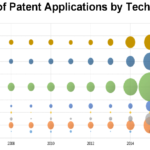

I always love seeing new 3D printing patent applications. There has been some wacky-looking stuff presented — Samsung’s recently granted patent for a holographic 3D printer comes to mind — but I’ve never seen anything like the technology Boeing has come up with. The aerospace giant has recently filed a patent application for a process that 3D prints levitating objects. Yes, levitating objects.
It seems ludicrous. Multiple 3D printer heads shoot material at a magical floating nugget that collects the material, layer by layer, and grows into, apparently, an airplane part. I can’t wrap my head around it, but Boeing is very serious. The proposed technology is called “Free-Form Spatial 3-D Printing Using Part Levitation,” and it involves a “nugget” (yes, that is in fact the scientific term) made of printed material that is suspended in space via magnetic fields. Several printer heads surround said nugget and deposit additional printing material onto it from all sides.
“There is a need for an Additive Manufacturing (AM) method and apparatus that eliminates the need for a platform and/or support materials to stabilize the part during the fabrication process, and which removes limitations on the types of features that can be formed, allowing full body 3D printing of complex parts,” Boeing states.
The magnetic fields also allow the object to be rotated in space, so that material can be added to the bottom as well. The patent application actually proposes several possible methods of levitating the object. Most of them involve the manipulation of magnets, for example: “…supercooling the part until the part becomes a superconductor, and subjecting the part to a magnetic field producing a magnetic force that is substantially equal to a gravitational force, and trapping the part within the node.”

So simple, no? Another proposed method of levitation involves generating acoustic waves so powerful that they force the nugget into the air; it’s then held in the air by an acoustic reflector that reflects the sound waves and creates a “standing wave pattern” that keeps the part in place while the print heads do their thing. Those multiple print heads, by the way, should make the printing process incredibly fast. And the fact that there’s no build plate means that there’s no limit on the size of objects can be printed. Boeing, being an aircraft manufacturer, obviously proposes using this system to built aircraft parts, or, it appears, even entire airplanes. As the patent application states:
“…The aircraft produced by exemplary method may include an airframe with a plurality of systems and an interior. Examples of high-level systems include one or more of a propulsion system, an electrical system, a hydraulic system, and an environmental system. Any number of other systems may be included.”
I’m not even going to begin to think about the logistics of it all, but it’s really a brilliant proposal. If it comes to fruition and doesn’t disappear into the vast black hole of patent applications, it could be used for any number of industries. 3D printing is already a technology that has done away with many of the limitations of traditional manufacturing, but this process could do away with the limitations of traditional 3D printing. And that would mean a technology that is, well, limitless. You can read the entire patent application here, and Patent Yogi has kindly put together a video to help you visualize how this technology would work. See below. Were you surprised to hear about this? Discuss in the 3D Printed Levitating Object forum over at 3DPB.com.
If you're looking to get architectural 3D animation in the USA, our service provides an exceptional way to bring your architectural concepts to life through dynamic, immersive visuals. Through our platform, you can easily request high-quality 3D animations that showcase your designs in motion, offering a detailed view of your project from multiple angles and perspectives. Whether it's for a real estate development, a commercial building, or an urban planning project, our expert team ensures that every detail is captured in a visually compelling animation.
Through our website, you can seamlessly get architectural 3D animation tailored to your project’s specific needs. With our help, you can offer potential clients or investors an engaging experience that goes beyond static images. By integrating CGI animations with real-world settings, lighting, and textures, our team creates a lifelike experience that allows your audience to interact with your project as though it were already built. This service is perfect for presenting complex designs in a clear, visually attractive way that stands out in the competitive architectural market.




